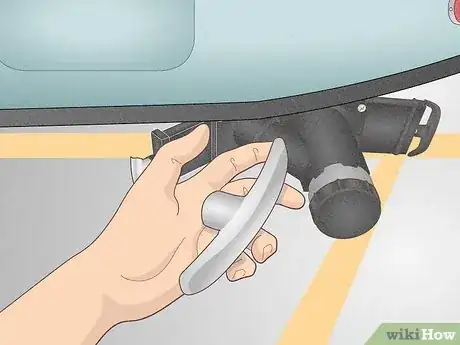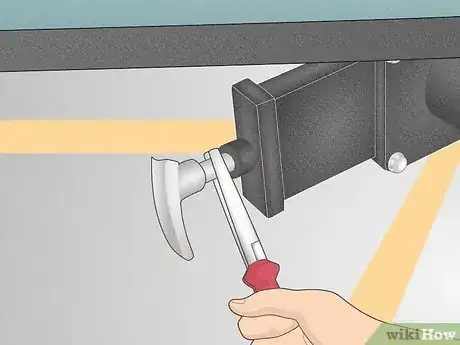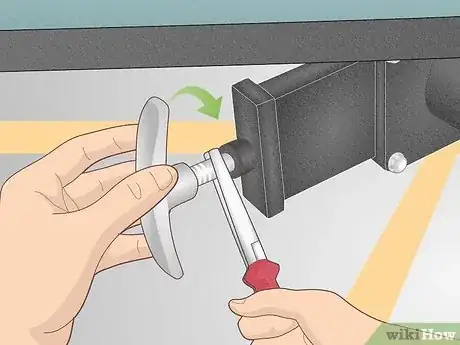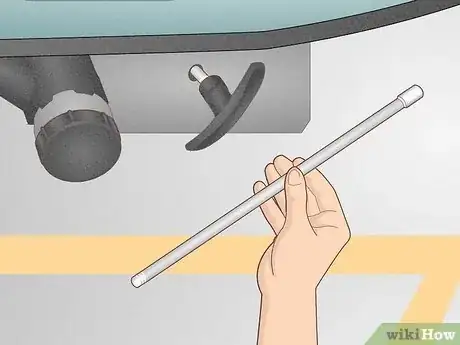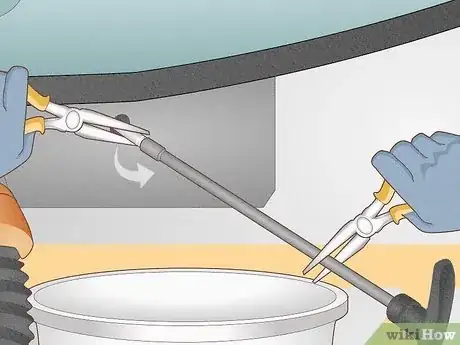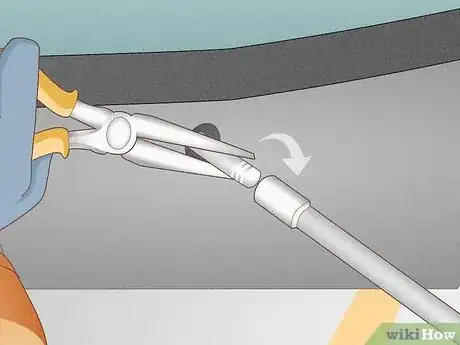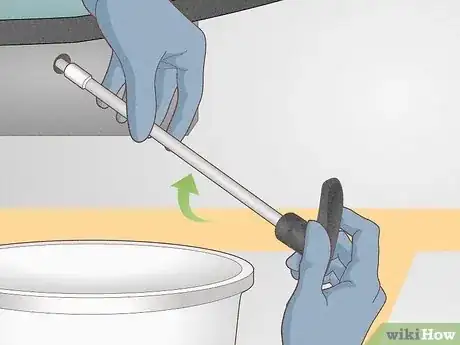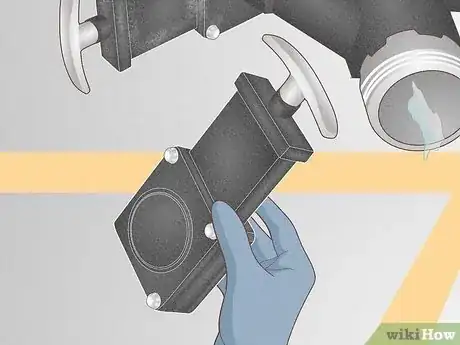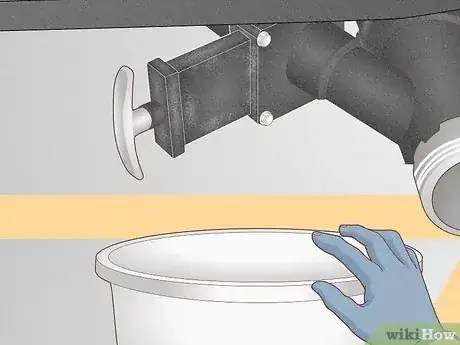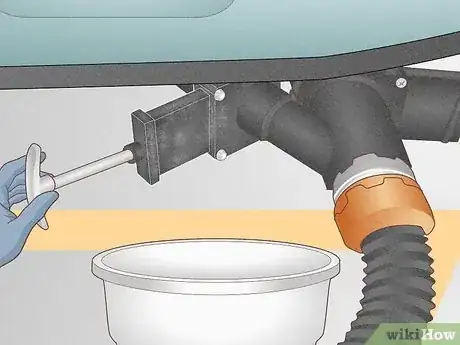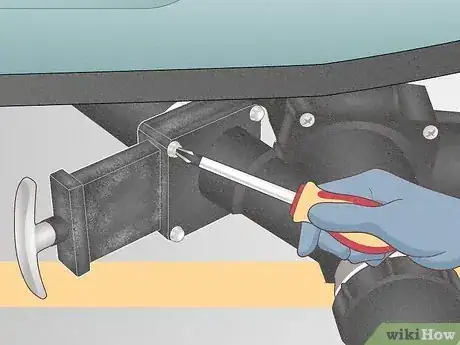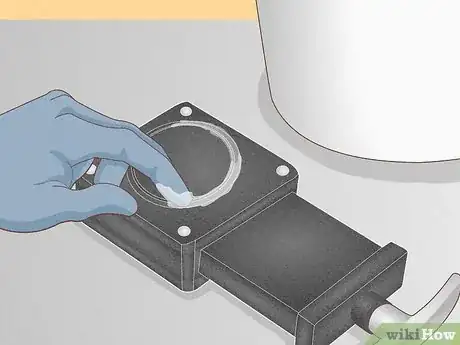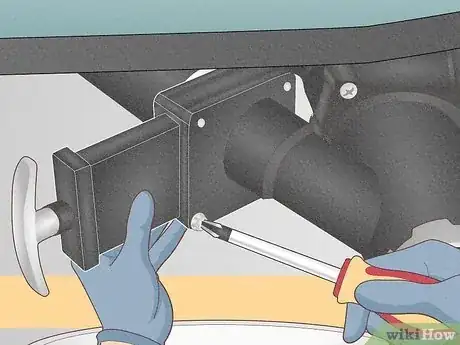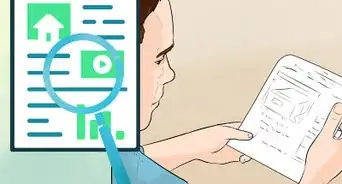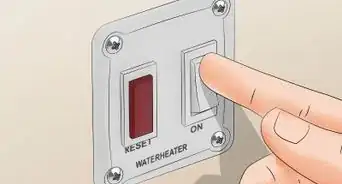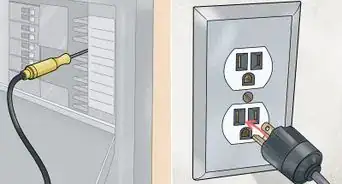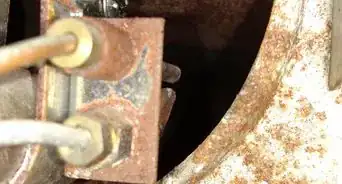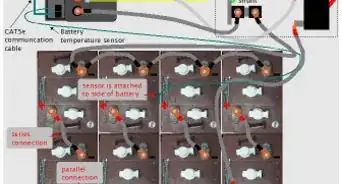This article was co-authored by wikiHow staff writer, Caroline Heiderscheit. Caroline Heiderscheit is a Staff Writer for wikiHow living in Santa Monica, CA. She has two years of experience working in content, including a year of editing work for first-time novelists. Caroline graduated from Stanford University in 2018 with degrees in American Studies and Creative Writing.
There are 7 references cited in this article, which can be found at the bottom of the page.
This article has been viewed 32,169 times.
Learn more...
Do you suspect that there's something wrong with your RV's black or gray wastewater tank valve? Maybe your handle broke, maybe your valve won't open completely, or maybe you've spied a leak. If the handle or rod need replacing, it'll be easy to tell (because they'll have visibly snapped or won't be working properly)—and we've outlined those processes below. If you're noticing leaks, either your black or gray valve needs replacing. Below, we're walking you through all 3 processes in detail. Let's get started!
Things You Should Know
- Replace your T-handle or extension rod easily by unscrewing the old piece and fastening a replacement in the same location.
- When you notice water leaking from your cap, this means one of your valves (either black or gray) needs to be replaced.
- To replace either your black or gray wastewater valve, simply unscrew 4 screws that hold it in place, slide the old valve out, and fasten the new valve in place.
Steps
Fixing a Broken T-Handle
-
1Order a replacement T-handle. These pieces aren't universal, so find your replacement handle through your drain valve’s manufacturer. Spot the manufacturer’s name printed directly on the handle or on a sticker near the waste valve. Then, order a replacement T-handle online or call the manufacturer directly. Now, all you have to do is wait for it to arrive![1]
- Companies usually only make 1 type of T-handle so this should be easy. Just ask for a replacement T-handle and they should know exactly what you need.
- The handle often breaks after a few years of use because it’s used to slide the extension rod in and out. Repeatedly pulling and pushing the handle will cause the threading to wear down, and it will eventually break.
- A replacement handle will cost you $3-10.
-
2Slide the extension rod out 1–2 in (2.5–5.1 cm) and grip it with pliers. First, go to your sewage line where you dump the gray or black tank. Either pull the rod out by hand or grip the broken piece with pliers and slide it out a little. Then, grip the metal rod behind the handle with pliers to hold it still and keep it from spinning while you replace the T-handle.Advertisement
-
3Turn the T-handle counterclockwise by hand to unscrew it. Keep holding the rod down with your pliers. Use your free hand to spin the handle. Keep turning the handle over and over until it pops off of the end of the extension rod.
- This is a great opportunity to wipe the threading down with a clean cloth. If the end of the rod looks a little dirty, just grab a clean rag and rub the threading to remove any gunk.
-
4Attach your new handle and turn it clockwise to install it. Do not release your grip with the pliers to keep the rod from sliding inside the waste valve. Slide your new handle over the end of the extension rod. Turn it clockwise until the threading catches. When it does, continue turning it by hand until you can't turn it any more. Release the handle and the pliers to finish replacing the handle.[2]
Installing a New Extension Rod and Handle
-
1Get a replacement rod that matches the old one. If your valve won’t open all the way or the extension rod gets stuck when you pull the T-handle, replace the extension rod. These pieces aren't universal, so order from your manufacturer, either online or by phone. Look at your T-handle or waste valve to find the company’s name.
- A bent or broken rod will make it difficult to open or close the valve, which can keep your sewage from staying in the pipe behind the valve.
- Be sure to order both the aluminum rod and a T-handle. These pieces normally come together, but if they don't, buy them separately from the manufacturer.
- Measure the rod if the manufacturer makes handles in various sizes. To do this, pull your rod out and measure its length—the most common size is 72 inches (180 cm). We cover the rod removal process in the following steps.
- This rod will cost roughly $5-10.
-
2Drain your tank before replacing the handle. First, put on some protective gloves (you'll be working with sewage, after all!). Go to the sewer line where you dump your waste. Take your sewer hose and hook it up to the septic tank or sewer line you’re draining it into. Then, connect the other end of your hose to your valve. Pull the T-handle to open the valve and drain your tank, the same way you would normally.[3]
- Slide a bucket under the faulty valve if your extension rod is leaking when you open it.
-
3Using pliers, unscrew the old extension rod. Pull the valve out as far as you can and with your pliers, grip the extension rod. Then, use another set of pliers to hold the drain valve rod in place. Rotate the extension rod counterclockwise to unscrew it from the valve.
- Just to clarify here, there are 2 rods connecting to your drain valve. The extension rod is the portion closest to the T-handle. The piece that sticks out of the base, on the other hand, is attached directly to the drain valve. If this piece is faulty, you need to replace the entire valve (which we'll go over in the next section).
- Rotate the extension rod by hand once you loosen it with the pliers if you're able.
-
4Slide the new extension rod over the drain valve rod. Take the replacement rod and slide the open end over the threading on the drain valve rod. Rotate it clockwise by hand until the threading catches.
-
5Tighten the rod by hand and install the new T-handle. Continue turning the extension rod by hand until you can’t rotate it any further. Once the extension rod is attached to the drain valve rod, screw the T-handle into the end of the extension rod by hand. Turn it clockwise until you can’t rotate the handle any further.
- Dump any excess bucket waste into the septic tank you hooked the RV up to. Or, dump it in your toilet carefully and flush to send the waste back through the system.
- Take your gloves off and throw them out after you’re done. If they got dirty, wrap them in a plastic bag before tossing them out. When you're finished, be sure to wash your hands thoroughly.
Changing a Black or Gray Waste Valve
-
1Look at the sewage cap to determine if you need to replace the black or gray valve. If there's leakage in your cap, then one of your valves needs replacing. When you open your sewage cap, take a closer look at the kind of water flowing out. The water falling out of your drain outlet is coming straight from the culprit. Look at the color of the water and take a couple whiffs. Do you notice an odor? [4]
- If the water is dark and foul-smelling, it's your black valve that needs replacing.
- If the water is clear and has no odor, it's your gray valve.
- You can also determine which valve is leaking based on the size, which we describe in the next step.
- The process below describes both black and gray waste valve replacement. The waste valve is always located right behind the sewage pipe where you dump your gray or black tank. It has a square frame and a handle sticking out of the side.
-
2Order a replacement waste valve and put on nitrile gloves. Unlike the extension rods and T-handles, waste valves are universal. Typically, gray valves are 1.5 in (3.8 cm) and black valves are 3 in (7.6 cm). If you're unsure about your valve's size, measure the diameter of the surrounding waste pipes and match your new valve to it. Put on some nitrile gloves before you get started, because you'll be working around wastewater.
- Be sure to get the valve with the extension rod and T-handle. Almost every valve comes with these pieces automatically, but double-check just to be safe.
-
3Slide a bucket underneath the junction where the valve and pipe meet. Take a bucket or empty storage container and place it under the valve where the extension rod sits. Eventually, you'll take this piece off (and wastewater might drip out!), so don't skip this step.[5]
- Unfortunately, this process may get a little messy. You’re dealing with a pipe that carries waste, so be prepared for funky odors.
-
4Drain and flush your tank to remove any existing waste. Before you can replace the valve, flush the tank. Hook your sewer hose up to the sewer line on your RV and attach the other end to a septic tank or campsite sewer line. Open the valve that you're replacing and drain the tank completely the same way you normally do. Close the valve by pushing the T-handle in all the way and cap your sewer lines when you’re done.[6]
- Make your black tank system even cleaner by flushing the toilet repeatedly. To clean a gray tank, run the shower. This will send clean water through the pipes to clear them out.
- If you have a rinse setting on the tank, run it after you empty the tank. This is the best way to clean the system out.
-
5Unscrew the 4 bolts holding the waste valve in place. There are 4 screws or nuts holding the valve in place. They are on the rectangular lip of the valve. Inspect these screws or nuts to see if you need a flathead, Phillips head, or wrench to take them off. Then, unscrew each of these nuts or screws to unlock your waste valve.[7]
- This can be kind of tough depending on the location of the valve. If your waste valve is tucked under the vehicle, you may need to crawl underneath or reach behind the sewer line to access the screws.
-
6Lubricate your new flanges if necessary and pop them into place. Take your new valve out of the box and read the instructions. If the 2 circular flanges are pre-lubricated, you’re ready to proceed to the next step. If they aren’t, rub them with petroleum jelly to protect them during installation. Then, gently push both seals into place on either side of the valve. Now you're ready to install![8]
- The new valve will come with 2 round flanges (or seals). The flanges fit around each pipe connection on the sides of the valve to reduce friction between the valve and the sewer pipes.
- Note that if your waste valve’s instructions don’t mention lubricating the flanges, you can safely assume you don’t need to lubricate.
-
7Flex apart the connecting tubes and remove the valve. On most RVs, an inlet and outlet tube will be running from one side of the valve to the other. Gently pull these away from the valve so that there's enough room to remove it entirely. If possible, apply equal pressure to both sides of the connecting tubes—putting too much pressure on one side or the other could be damaging. Finally, slip the old valve out.[9]
-
8Slide the new valve in between the waste pipes. Flex the waste pipes apart to make room for your new valve. Slide the valve into its old home and push the 2 pipes against the waste valve on either side. It's crucial that you check that the pipes are flush with the openings on the valve. Squeeze the valve and 2 pipes together and line the screw slots on the valve's lip up with the screw slots on the pipe's frame.[10]
- You can orient the valve in 4 directions since the screws are arranged in a square. Pay attention to where you’re installing the handle to give the extension rod room to pull out.
-
9Tighten the screws or nuts to finish installing the new valve. Use a screwdriver or socket wrench to tighten each of the 4 screws or nuts. Tighten all 4 screws or nuts halfway to ensure they’re even before tightening them as hard as you can. Once you can’t turn the screws or nuts anymore, run some water or flush an empty toilet to make sure your new valve doesn’t leak. If you still notice leaks, check the valve's connections. A cracked pipe could be the culprit, and for that, you'll want a professional's help.[11]
- If the extension rod isn’t built into the valve (it normally is), attach it to the valve afterward by twisting it over the valve rod sticking out of the side.
- Flush the entire system with clean water after installing the new valve to make sure it doesn’t leak.
- Empty the waste bucket in the campsite’s septic tank or flush it down your toilet carefully. Discard your gloves after you’re done by placing them in a plastic bag and tying the handles. Wash your hands thoroughly when you’re done.
Things You’ll Need
Fixing a Broken T-Handle
Installing a New Extension Rod and Handle
- Bucket
- Socket wrench (optional)
Changing a Black or Gray Waste Valve
- Replacement valve
- Screwdriver or wrench
- Bucket
- Waste valve and nitrile gloves
References
- ↑ https://youtu.be/k7qfzLqlUp0?t=26
- ↑ https://youtu.be/vDBXOksBBp4?t=103
- ↑ https://www.campanda.com/magazine/rv-tanks-guide/
- ↑ https://youtu.be/U8xhVxXPtB8?t=40
- ↑ https://www.getawaycouple.com/heres-how-to-fix-your-stuck-rv-black-tank-valve/
- ↑ https://www.campanda.com/magazine/rv-tanks-guide/
- ↑ https://www.getawaycouple.com/heres-how-to-fix-your-stuck-rv-black-tank-valve/
- ↑ https://www.doityourselfrv.com/repair-bad-rv-waste-dump-gate-valve/
- ↑ https://youtu.be/U8xhVxXPtB8?t=448
